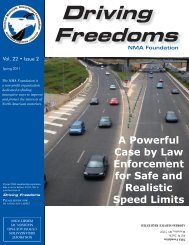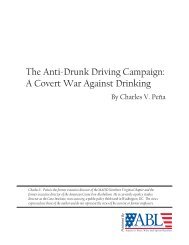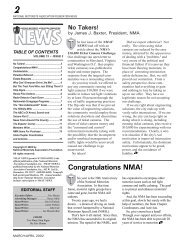The Flawed Nature of the Calibration Factor in Breath-Alcohol Analysis
The Flawed Nature of the Calibration Factor in Breath-Alcohol Analysis
The Flawed Nature of the Calibration Factor in Breath-Alcohol Analysis
You also want an ePaper? Increase the reach of your titles
YUMPU automatically turns print PDFs into web optimized ePapers that Google loves.
In <strong>the</strong> Classroom<strong>The</strong> <strong>Flawed</strong> <strong>Nature</strong> <strong>of</strong> <strong>the</strong> <strong>Calibration</strong> <strong>Factor</strong> <strong>in</strong> <strong>Breath</strong>-<strong>Alcohol</strong><strong>Analysis</strong>Dom<strong>in</strong>ick A. LabiancaDepartment <strong>of</strong> Chemistry, Brooklyn College <strong>of</strong> <strong>The</strong> City University <strong>of</strong> New York, Brooklyn, NY 11210In recent years, a number <strong>of</strong> articles have appeared <strong>in</strong>this Journal address<strong>in</strong>g various aspects <strong>of</strong> breath-alcohol analysis,<strong>in</strong>clud<strong>in</strong>g <strong>the</strong> role <strong>of</strong> Henry’s law <strong>in</strong> this type <strong>of</strong> analysisand <strong>the</strong> variability <strong>of</strong> <strong>the</strong> blood-alcohol to breath-alcohol partitionratio (blood:breath ratio, or BBR) central to <strong>the</strong> conversion<strong>of</strong> any measured breath-alcohol concentration(BrAC Meas. ) <strong>in</strong>to a correspond<strong>in</strong>g estimated blood-alcoholconcentration (BAC Est. ) (1–4). More specifically, with<strong>in</strong> <strong>the</strong>context <strong>of</strong> breath-alcohol analysis, Henry’s law describes <strong>the</strong>equilibrium distribution <strong>of</strong> ethanol vapor between alveolarair and circulat<strong>in</strong>g pulmonary blood at 34 °C, <strong>the</strong> averagetemperature <strong>of</strong> such air. When breath analysis is used to determ<strong>in</strong>ea subject’s BAC Est. from his or her BrAC Meas. , eq 1,derived from Henry’s law, is used (2). In this equation, <strong>the</strong>2100:1 BBR, reflects <strong>the</strong> assumption that for all subjects undergo<strong>in</strong>ga breath-alcohol analysis and hav<strong>in</strong>g an average alveolarair temperature <strong>of</strong> 34 °C, 2100 mL <strong>of</strong> this expired airconta<strong>in</strong>s <strong>the</strong> same mass <strong>of</strong> ethanol as 1 mL <strong>of</strong> blood.no. g ethanol 2100 mL breath no. g ethanol= ×100 mL blood 1 mL blood 210 L breath(1)BAC Est. BBR BrAC Meas.<strong>The</strong> Role <strong>of</strong> Simulator SolutionsA breath-alcohol simulator is an ideal Henry’s law systemconsist<strong>in</strong>g <strong>of</strong> a dilute solution <strong>of</strong> ethanol <strong>in</strong> water ma<strong>in</strong>ta<strong>in</strong>edat 34 °C. Simulator solutions are <strong>in</strong>tended to simulatehuman test subjects and are rout<strong>in</strong>ely used to check <strong>the</strong>accuracy <strong>of</strong> breath-alcohol analyzers that rely on a specificBBR, def<strong>in</strong>ed <strong>in</strong> <strong>the</strong> United States <strong>of</strong> America as 2100:1.<strong>The</strong>se analyzers are utilized by law enforcement agencies todeterm<strong>in</strong>e <strong>the</strong> alcohol concentrations <strong>in</strong> samples <strong>of</strong> alveolarair provided by suspected DWI (driv<strong>in</strong>g-while-<strong>in</strong>toxicated)arrestees. Measured BrACs are reported <strong>in</strong> concentration units<strong>of</strong> g ethanol/210 L breath <strong>in</strong> jurisdictions where legal limitsare def<strong>in</strong>ed <strong>in</strong> terms <strong>of</strong> specific BrACs, for example, 0.08 gethanol/210 L breath <strong>in</strong> California. In o<strong>the</strong>r jurisdictions,measured BrACs are converted <strong>in</strong>to equivalent estimatedBACs via eq 1. So <strong>in</strong> New York, for example, where <strong>the</strong> legallimit is 0.10 g ethanol/100 mL blood, or 0.10%, a BrAC Meas.<strong>of</strong> 0.10 g ethanol/210 L breath is equivalent to a BAC Est.<strong>of</strong> 0.10%.For a simulator solution ma<strong>in</strong>ta<strong>in</strong>ed at 34 °C, <strong>the</strong> partitionratio correspond<strong>in</strong>g to <strong>the</strong> BBR would be <strong>the</strong> water-alcoholto air-alcohol partition ratio (k w/a ). This ratio has beenestimated by Dubowski to be 2573:1, derived from his leastsquares,best-fit regression analysis <strong>of</strong> data documented <strong>in</strong> anumber <strong>of</strong> relevant studies (5). An equivalent form <strong>of</strong> <strong>the</strong>equation stemm<strong>in</strong>g from Dubowski’s analysis is eq 2, whichyields <strong>the</strong> value <strong>of</strong> 2573:1 cited above for k w/a when x, <strong>the</strong>temperature <strong>in</strong> °C, is 34 °C.1 × 10 3k w/a=(2)0.04145e 0.06583 xLater <strong>in</strong>vestigations by Dubowski and Essary (6, 7) andSpeck et al. (8) reveal ranges <strong>of</strong> k w/a whose upper and lowerlimits do not differ significantly from Dubowski’s empiricallyderived ratio <strong>of</strong> 2573:1.Simulator-Based <strong>Calibration</strong>sGiven that breath-alcohol analyzers rely on a fixed BBR,all test subjects, <strong>in</strong>clud<strong>in</strong>g simulator solutions, are assumedto be characterized by <strong>the</strong> same partition ratio. So if a breathalcoholanalysis is conducted on a DWI arrestee <strong>in</strong> New York,for example, <strong>the</strong> breath-alcohol analyzer is calibrated with asimulator solution that is expected to generate a result <strong>of</strong>0.10% if <strong>the</strong> analyzer is function<strong>in</strong>g properly at a fixed partitionratio <strong>of</strong> 2100:1. This result can be calculated prior toa given calibration us<strong>in</strong>g eq 3: R denotes <strong>the</strong> partition ratio<strong>of</strong> <strong>the</strong> test subject, which <strong>in</strong> <strong>the</strong> case <strong>of</strong> a simulator solutionis estimated to be 2573:1 at 34 °C; AC Actual is <strong>the</strong> true alcoholconcentration <strong>of</strong> <strong>the</strong> test subject, which for a simulatorsolution <strong>in</strong>tended to produce a 0.10% result on a properlyfunction<strong>in</strong>g breath-alcohol analyzer is 0.1226% (5); andAC Reported is <strong>the</strong> alcohol concentration reported by a breathalcoholanalyzer rely<strong>in</strong>g on a 2100:1 partition ratio. 1 Clearly,when 2573 and 0.1226% are substituted, respectively, for Rand AC Actual <strong>in</strong> eq 3, <strong>the</strong> truncated value <strong>of</strong> AC Reported is0.10%.AC Reported=2100 × ACActualR(3)<strong>The</strong> NHTSA Conform<strong>in</strong>g Products List<strong>Breath</strong>-alcohol analyzers that appear on <strong>the</strong> Conform<strong>in</strong>gProducts List (CPL) <strong>of</strong> Evidential <strong>Breath</strong> Measurement Devices<strong>of</strong> <strong>the</strong> U.S. Department <strong>of</strong> Transportation’s National HighwayTraffic Safety Adm<strong>in</strong>istration (NHTSA) are those devicesthat have been evaluated for precision and accuracy atcerta<strong>in</strong> values <strong>of</strong> AC Reported . Specifically, <strong>in</strong>struments that meet<strong>the</strong> model specifications established <strong>in</strong> 1993 (10) andamended <strong>in</strong> 1994 (11) are those <strong>in</strong>struments that have beenevaluated for precision and accuracy at 0.000 (blank read<strong>in</strong>g),0.020, 0.040, 0.080, and 0.160% alcohol concentrations, andthat generate results with<strong>in</strong> an acceptable systematic errorrange <strong>of</strong> ±0.002% (±2% at a BrAC <strong>of</strong> 0.10 g/210 L or a BAC<strong>of</strong> 0.10%). For <strong>the</strong> blank read<strong>in</strong>g, <strong>the</strong> regulations require that,“<strong>The</strong> tester shall use his or her own breath ... and he or shemay not consume alcohol for a period <strong>of</strong> 48 hours prior tothis test or smoke for a period <strong>of</strong> 20 m<strong>in</strong>utes prior to thisJChemEd.chem.wisc.edu • Vol. 79 No. 10 October 2002 • Journal <strong>of</strong> Chemical Education 1237
In <strong>the</strong> Classroomtest” (11). For <strong>the</strong> rema<strong>in</strong><strong>in</strong>g test concentrations, or AC Reportedvalues <strong>of</strong> 0.020, 0.040, 0.080, and 0.160%, simulator solutionshav<strong>in</strong>g concentrations correspond<strong>in</strong>g to AC Actual values<strong>of</strong> 0.0245, 0.0490, 0.0980, and 0.1960%, respectively, wouldbe used. <strong>The</strong>se concentrations can be determ<strong>in</strong>ed by us<strong>in</strong>geq 3 to solve for AC Actual <strong>in</strong> each case, <strong>in</strong> accord with eq 4,with 2573 substituted for R.AC = RActualAC2100 × Reported(4)<strong>The</strong> <strong>Flawed</strong> <strong>Nature</strong> <strong>of</strong> <strong>the</strong> <strong>Calibration</strong> <strong>Factor</strong><strong>The</strong> fundamental flaw <strong>of</strong> simulator-based calibrations isthat, while <strong>the</strong>y produce values <strong>of</strong> AC Reported with<strong>in</strong> an establishedmarg<strong>in</strong> <strong>of</strong> error when a breath-alcohol analyzer functionsproperly at 2100:1 (or at ano<strong>the</strong>r fixed BBR, such as2000:1 or 2300:1(12), both <strong>of</strong> which have been adopted outside<strong>the</strong> United States), <strong>the</strong>y do not guarantee accurate resultswhen humans undergo breath-alcohol analysis. This flawoccurs because a properly ma<strong>in</strong>ta<strong>in</strong>ed simulator solution isan ideal Henry’s law system, as noted above, while a humansubject is not. <strong>The</strong>refore, calibrations <strong>of</strong> breath-alcohol analyzerswith such solutions deal only with <strong>in</strong>strument error,one <strong>of</strong> <strong>the</strong> three types <strong>of</strong> systematic error (13). Where humantest subjects are concerned, however, those calibrationsdo not address method error, <strong>the</strong> second type <strong>of</strong> systematicerror (13), which stems from <strong>the</strong> nonideal behavior <strong>of</strong> humansubjects and can be significant. 2 In this regard, Jones(14) reported that 70% <strong>of</strong> <strong>the</strong> uncerta<strong>in</strong>ty <strong>in</strong> breath test resultsis attributable to physiological variables, and Simpson(15) reported that 90% <strong>of</strong> <strong>the</strong> uncerta<strong>in</strong>ty <strong>in</strong> breath test resultsis “ascribable to variables <strong>in</strong>volv<strong>in</strong>g <strong>the</strong> subject.” <strong>The</strong>blanket claim, <strong>the</strong>refore, that <strong>the</strong> result <strong>of</strong> a breath-alcoholanalysis reflects <strong>the</strong> subject’s actual BAC with<strong>in</strong> <strong>the</strong> same narrowmarg<strong>in</strong> <strong>of</strong> error characteriz<strong>in</strong>g simulator-based calibrations,is mislead<strong>in</strong>g and untenable.This argument applies as well to calibrations <strong>of</strong> breathalcoholanalyzers <strong>in</strong>volv<strong>in</strong>g dry gas ethanol standards that arealso used to simulate breath samples provided by human testsubjects. <strong>The</strong>se standards are available as ethanol-<strong>in</strong>-nitrogencompressed gas mixtures hav<strong>in</strong>g certified ethanol concentrationsthat can be expressed <strong>in</strong> units <strong>of</strong> g ethanol/210 L gas at34 °C and 760 torr (16). Dubowski and Essary (16) haveconfirmed that calibrations derived from such standards generateresults consistent with those based on aqueous simulatorsolutions. <strong>The</strong> effluent from any <strong>of</strong> <strong>the</strong> latter, <strong>in</strong> contrastto <strong>the</strong> dry gas standard, is essentially saturated with watervapor and is termed wet gas. <strong>Breath</strong>-alcohol analyzers capable<strong>of</strong> utiliz<strong>in</strong>g both wet gas and dry gas calibrations are equippedwith a barometric sensor to facilitate corrections for barometricpressure variability when <strong>the</strong> latter type <strong>of</strong> calibrationis used. 3<strong>The</strong> physiological variables, referred to above, that affect<strong>the</strong> accuracy <strong>of</strong> a breath-alcohol analysis <strong>in</strong>volv<strong>in</strong>g a humansubject are addressed below with<strong>in</strong> <strong>the</strong> context <strong>of</strong> breathtest results reported <strong>in</strong> terms <strong>of</strong> BAC Est. . It must be emphasized,however, that <strong>the</strong>se variables apply as well <strong>in</strong> those caseswhere breath test results are reported <strong>in</strong> terms <strong>of</strong> BrAC Meas. .This is a consequence <strong>of</strong> <strong>the</strong> fact that direct BrAC statutes <strong>in</strong><strong>the</strong> United States and elsewhere are based on a 2100:1 BBR(or on <strong>the</strong> o<strong>the</strong>r values <strong>of</strong> <strong>the</strong> BBR cited above), a po<strong>in</strong>t thatJones has stated explicitly (12) and that Labianca andSimpson (17) have demonstrated unequivocally via a simplema<strong>the</strong>matical pro<strong>of</strong>.Variability <strong>of</strong> <strong>the</strong> BBRExtensive data demonstrat<strong>in</strong>g BBR variability have beendocumented <strong>in</strong> <strong>the</strong> scientific literature over <strong>the</strong> years, so onlykey conclusions stemm<strong>in</strong>g from <strong>the</strong>se data and concern<strong>in</strong>g<strong>the</strong> postabsorptive and absorptive states <strong>of</strong> alcohol metabolismare emphasized here.For <strong>the</strong> postabsorptive state, Dubowski (18) reportednormally distributed BBR data characterized by a mean <strong>of</strong>2280:1 and a statistical range <strong>of</strong> 1555:1 to 3005:1 for 99.7%<strong>of</strong> <strong>the</strong> dr<strong>in</strong>k<strong>in</strong>g population. Based on <strong>the</strong> standard 2100:1ratio, it can be shown that Dubowski’s data are consistentwith a relative error range <strong>of</strong> 26% to +43%. Moreover, thosedata reflect a ratio <strong>of</strong> BAC underestimates to overestimates<strong>of</strong> 77:23 (15, 19). In contrast, Jones’s postabsorptive data (20)<strong>in</strong>dicate a lower, although still significant, ratio <strong>of</strong> underestimatesto overestimates <strong>of</strong> 69:31 (21).A noteworthy po<strong>in</strong>t <strong>in</strong> this regard is that <strong>the</strong> typical wetgas simulator calibration <strong>of</strong> a breath-alcohol analyzer is anexample <strong>of</strong> an analysis that produces an underestimated resultand, fur<strong>the</strong>rmore, def<strong>in</strong>itive pro<strong>of</strong> <strong>of</strong> <strong>the</strong> <strong>in</strong>ability <strong>of</strong> suchanalyzers to adjust for test subjects hav<strong>in</strong>g partition ratios thatdeviate from 2100:1. As noted above, a simulator solutionwhose AC Actual is 0.1226% is expected to generate a truncatedAC Reported <strong>of</strong> 0.10% on a properly function<strong>in</strong>g breath-alcoholanalyzer operat<strong>in</strong>g at a BBR <strong>of</strong> 2100:1. This is obviously afalse-low result for <strong>the</strong> simulator solution <strong>in</strong> question, but,never<strong>the</strong>less, <strong>the</strong> anticipated, correct false-low result that wouldbe generated by a breath-alcohol analyzer rely<strong>in</strong>g on a partitionratio lower than that <strong>of</strong> <strong>the</strong> 2573:1 def<strong>in</strong><strong>in</strong>g <strong>the</strong> simulatorsolution. Moreover, and even more significant because <strong>of</strong><strong>the</strong> adverse societal impact that would ensue, is <strong>the</strong> hypo<strong>the</strong>ticalscenario <strong>in</strong> which <strong>the</strong> simulator solution would be aDWI arrestee <strong>in</strong> a jurisdiction hav<strong>in</strong>g a legal limit <strong>of</strong> 0.12%.Although <strong>the</strong>re are no such jurisdictions <strong>in</strong> <strong>the</strong> United States,<strong>the</strong> po<strong>in</strong>t is that, such an arrestee, although clearly guilty <strong>of</strong>DWI, would not be so charged because his or her AC Reportedwould fall below <strong>the</strong> legal limit.For <strong>the</strong> absorptive state, <strong>the</strong> effect <strong>of</strong> BBR variability issubstantially more pronounced (22). Mason and Dubowski(23) have emphasized that, “... when blood and breath testsare available to a subject, <strong>the</strong> breath test can be discrim<strong>in</strong>atory<strong>in</strong> yield<strong>in</strong>g a higher result than a blood test dur<strong>in</strong>gabsorption.” More recently, Dubowski (18) added,“significant variations from [<strong>the</strong> postabsorptive mean BBR<strong>of</strong> 2280:1] exist dur<strong>in</strong>g active alcohol absorption and [as<strong>in</strong>dicated above] <strong>in</strong> some <strong>in</strong>dividuals even <strong>in</strong> <strong>the</strong>postabsorptive state.” In fact, Labianca and Simpson (24)determ<strong>in</strong>ed a mean absorptive state BBR <strong>of</strong> 1836:1, derivedfrom lognormal statistical analysis <strong>of</strong> <strong>the</strong> data <strong>of</strong> Giguiere andSimpson (25). <strong>The</strong> logarithm-transformed data are normallydistributed and <strong>in</strong>volve a statistical range <strong>of</strong> 1128:1 to 2989:1for 99% <strong>of</strong> <strong>the</strong> dr<strong>in</strong>k<strong>in</strong>g population <strong>in</strong> <strong>the</strong> absorptive state.This reflects a relative error range <strong>of</strong> 46% to +42% and aratio <strong>of</strong> underestimates to overestimates <strong>of</strong> 24:76. <strong>The</strong> data<strong>of</strong> Jones (20) for <strong>the</strong> absorptive state <strong>in</strong>dicate a less1238 Journal <strong>of</strong> Chemical Education • Vol. 79 No. 10 October 2002 • JChemEd.chem.wisc.edu
In <strong>the</strong> Classroompronounced, but certa<strong>in</strong>ly significant, ratio <strong>of</strong> underestimatesto overestimates <strong>of</strong> 35:65 (26).<strong>The</strong> Effect <strong>of</strong> TemperatureConsistent with Henry’s law is <strong>the</strong> fact that temperaturemust be controlled <strong>in</strong> any given application, and this is certa<strong>in</strong>ly<strong>the</strong> case for simulator solutions ma<strong>in</strong>ta<strong>in</strong>ed at 34 °C,as <strong>in</strong>dicated above. Yet oral temperature measurements <strong>of</strong>DWI arrestees are not part <strong>of</strong> <strong>the</strong> protocol used by law enforcementagencies, despite <strong>the</strong> fact that such measurementsand <strong>the</strong> use <strong>of</strong> appropriate corrections where necessary havebeen endorsed (27–29). In this regard, studies have shownthat <strong>the</strong> BBR changes with temperature by factors rang<strong>in</strong>gfrom 6.5%/°C (30) to 8.6%/°C (29).<strong>Breath</strong><strong>in</strong>g Pattern<strong>The</strong> length <strong>of</strong> time <strong>in</strong>volved <strong>in</strong> breath sample delivery isalso a critical variable <strong>in</strong> breath-alcohol analysis. Hlastala (31)has found that errors <strong>in</strong> BAC Est. <strong>of</strong> as much as ±50%, or more,can occur by alter<strong>in</strong>g <strong>the</strong> breath<strong>in</strong>g pattern. He attributes thisvariation to changes <strong>in</strong> alcohol concentration dur<strong>in</strong>g <strong>the</strong>breath<strong>in</strong>g process, stemm<strong>in</strong>g from cool<strong>in</strong>g and heat<strong>in</strong>g <strong>of</strong> <strong>the</strong>breath and airways. <strong>The</strong>se dynamics <strong>of</strong> airway alcohol exchangeeffect a positively sloped alveolar plateau (32). Thus<strong>the</strong> longer a test subject exhales <strong>in</strong>to a breath-alcohol analyzerafter breath<strong>in</strong>g <strong>the</strong> cooler air <strong>of</strong> <strong>the</strong> surround<strong>in</strong>gs, <strong>the</strong>greater <strong>the</strong> positive deviation from <strong>the</strong> true BAC. Hlastala(31) <strong>of</strong>fers <strong>the</strong> example <strong>of</strong> a BAC Est. <strong>of</strong> 0.14% stemm<strong>in</strong>g froma lengthy breath sample delivery that would be consistent witha significantly lower BAC <strong>of</strong> 0.09%, where <strong>the</strong> former concentrationis nearly 50% more than <strong>the</strong> latter. Ohlsson et al.(33) also reported an <strong>in</strong>crease <strong>of</strong> over 50% <strong>in</strong> <strong>the</strong> BrAC Meas.<strong>of</strong> a subject with a large vital capacity (6.3 L) who exhaled<strong>in</strong>to <strong>the</strong> <strong>in</strong>frared-based breath-alcohol analyzer used <strong>in</strong> <strong>the</strong>analysis well beyond <strong>the</strong> required m<strong>in</strong>imum breath deliverytime <strong>of</strong> 4 s at a pressure exceed<strong>in</strong>g 11 torr.<strong>The</strong> effect <strong>of</strong> breath<strong>in</strong>g technique on <strong>the</strong> results <strong>of</strong>breath-alcohol analyses has also been explored by Jones (30).He found that, with breath-hold<strong>in</strong>g for 30 s prior to exhalation,BrAC Meas. and breath temperature <strong>in</strong>creased by as muchas 18% and 0.7 °C, respectively. On <strong>the</strong> o<strong>the</strong>r hand, hyperventilationfor 20 s prior to exhalation produced decreases<strong>in</strong> BrAC Meas. and breath temperature <strong>of</strong> up to 12% and 1.2°C, respectively.O<strong>the</strong>r Variables<strong>The</strong> health <strong>of</strong> a subject undergo<strong>in</strong>g breath-alcohol analysisis ano<strong>the</strong>r important consideration that cannot be ascerta<strong>in</strong>edby a breath-alcohol analyzer deemed to be accuratebased on a simulator calibration. A specific example <strong>in</strong> thisregard is a case described by Labianca and Simpson (17),which <strong>in</strong>volved a severely asthmatic defendant charged withDWI <strong>in</strong> California. <strong>The</strong> charge stemmed from a BAC Est. <strong>of</strong>0.09% at a time when <strong>the</strong> statutory legal limit <strong>in</strong> Californiabased on breath tests was 0.08% (as <strong>in</strong>dicated above, Californiacurrently has a direct breath statute <strong>in</strong> place that specifiesan equivalent legal limit <strong>of</strong> 0.08 g ethanol/210 L breath).<strong>The</strong> defendant presented evidence at his trial—derived fromcontrolled experiments conducted after he was charged and<strong>in</strong>volv<strong>in</strong>g <strong>the</strong> analysis <strong>of</strong> samples <strong>of</strong> his blood- and breathalcoholthat were taken essentially simultaneously—thatshowed a postabsorptive BBR <strong>of</strong> 1233:1. With 1233 substitutedfor R, eq 4 revealed that <strong>the</strong> defendant’s AC Actual was0.05%, and this led to <strong>the</strong> ultimate dismissal <strong>of</strong> <strong>the</strong> DWIcharge. <strong>The</strong> above case is certa<strong>in</strong>ly not unique. As emphasizedelsewhere (17), Russell and Jones (34), <strong>in</strong> <strong>the</strong>ir study<strong>of</strong> subjects with chronic obstructive pulmonary disease—which <strong>in</strong>cludes conditions such as asthma and emphysema(35)—concluded that, “quantitative measurement [<strong>in</strong>volv<strong>in</strong>gbreath-alcohol analysis] must be approached with caution”when test subjects lack effective pulmonary function.Additional variables that contribute to <strong>the</strong> uncerta<strong>in</strong>ty<strong>in</strong> results obta<strong>in</strong>ed from a properly calibrated breath-alcoholanalyzer <strong>in</strong>clude mouth-alcohol contam<strong>in</strong>ation and contam<strong>in</strong>ation<strong>of</strong> breath samples with compounds that can be mistakenlyidentified as alcohol. In <strong>the</strong> first <strong>in</strong>stance, studies onan <strong>in</strong>frared-based breath-alcohol analyzer, which apparentlyhas <strong>the</strong> capability <strong>of</strong> identify<strong>in</strong>g mouth-alcohol from sourcessuch as bleed<strong>in</strong>g gums or regurgitation <strong>of</strong> stomach contents,produced false-high results and demonstrated that <strong>the</strong> identify<strong>in</strong>gmechanism is not foolpro<strong>of</strong> (36). In <strong>the</strong> second case,<strong>the</strong> same type <strong>of</strong> <strong>in</strong>frared-based breath-alcohol analyzer 4 alsogenerated false-high results. This occurred because <strong>of</strong> <strong>the</strong> <strong>in</strong>ability<strong>of</strong> <strong>the</strong> <strong>in</strong>strument to dist<strong>in</strong>guish between <strong>the</strong> methylgroup <strong>of</strong> ethanol and <strong>the</strong> methyl group(s) <strong>of</strong> <strong>the</strong> solvents tolueneand <strong>the</strong> o-, m-, and p-xylenes to which test subjects hadbeen exposed (37).ConclusionObviously, method error <strong>in</strong> breath-alcohol analysis is asignificant issue, and if <strong>the</strong> impact <strong>of</strong> a relevant variable cannotbe ruled out <strong>in</strong> a particular DWI case, <strong>the</strong>n that variablemust be taken <strong>in</strong>to account. Clearly, <strong>the</strong> claim by users <strong>of</strong>breath-alcohol analyzers that such <strong>in</strong>struments are accuratebecause <strong>the</strong>y produce accurate results with<strong>in</strong> a specified marg<strong>in</strong><strong>of</strong> error when calibrated with simulator solutions (or drygas standards) is a very limited claim. <strong>The</strong> only acceptablepo<strong>in</strong>t <strong>of</strong> accuracy <strong>in</strong> this situation is that <strong>the</strong> breath-alcoholanalyzer that functions properly at a fixed BBR is capable <strong>of</strong>accurately analyz<strong>in</strong>g such a solution (or dry gas standard).However, when <strong>the</strong> same breath-alcohol analyzer is used totest a human subject, <strong>the</strong> result cannot automatically bedeemed accurate: it must be evaluated with<strong>in</strong> <strong>the</strong> context <strong>of</strong>its uncerta<strong>in</strong>ty. We teach our students <strong>in</strong> various chemistrycourses to abide by this protocol when evaluat<strong>in</strong>g experimentaldata, and we can certa<strong>in</strong>ly expect agencies that rely onwet or dry gas calibrations <strong>of</strong> breath-alcohol analyzers to abideby it as well.Moreover, it is important to place <strong>the</strong> message <strong>of</strong> thisarticle <strong>in</strong>to a broader, general context. That is, a calibrationstandard should, ideally, mimic <strong>the</strong> composition <strong>of</strong> <strong>the</strong> sampleto be analyzed (38). Thus, for example, if a particular sampleis to be analyzed for a metal ion via absorption analysis <strong>of</strong> acolored complex ion derived from <strong>the</strong> metal ion, <strong>the</strong> presence<strong>of</strong> sulfate and phosphate ions <strong>in</strong> <strong>the</strong> sample matrix can<strong>in</strong>terfere with <strong>the</strong> analysis. Sulfate and phosphate ions havea tendency to form colorless complexes with metal ions; as aconsequence a significant reduction <strong>in</strong> <strong>the</strong> concentration <strong>of</strong><strong>the</strong> desired colored complex ion and its associated absorbancecan occur for <strong>the</strong> sample <strong>in</strong> question. To <strong>of</strong>fset this type <strong>of</strong>matrix effect, calibration standards can be used that conta<strong>in</strong>JChemEd.chem.wisc.edu • Vol. 79 No. 10 October 2002 • Journal <strong>of</strong> Chemical Education 1239






